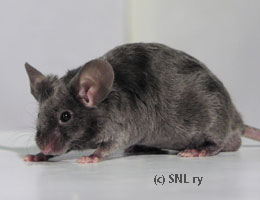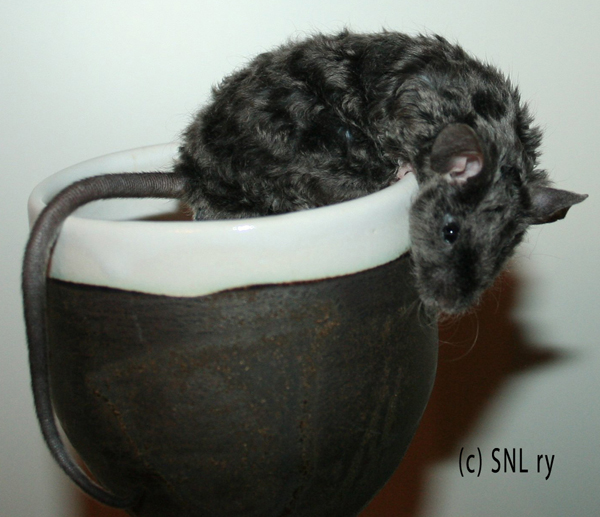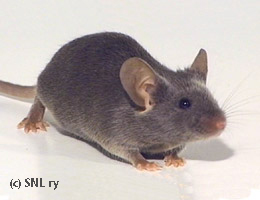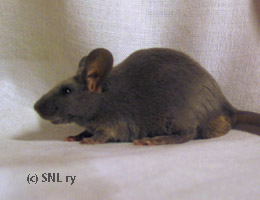Varieties
I - Self
Blue (bl)
a/a B/* d/d C/* P/*
(ora/a B/* D/* C/* P/* ln/ln, leaden or "mock blue")
"The colour should be a medium slate blue. Eye black."
Breeding information below the pictures.
Quick Look
Blue is a very old mutation and has been available within the mouse fancy for quite some time. For example a British mouse care and breeding guide from the late 19th century mentions a "plum or lavender" coloured mouse.
Like beige, blue comes in a wide variety of shades from mealy light blue to almost black. The ideal shade called for in standard is the medium one, ?medium slate blue?. The whole mouse, including the extremities and the belly, should be of a good blue colouration.
Blue mice do not only come in a variety of shades, they tend to darken with age. A young blue sporting the perfect shade can become too dark with age, while a mouse that is somewhat too light may grow up to be a winning show blue. However, a brownish or "mealy" blue will not develop into a good specimen.
Blue mice tend to suffer from the same faults as black: tan or white hairs in the coat, light feet, tan throat spots and a brownish tinge to the colour. The faulty tan (or white) hairs can be usually found in the following locations: on the throat (throat spot); behind the ears and inside the ears; along the sides where the demarcation line would be if the mouse were a blue tan; around the teats on females; around the vent; on the feet. Of these, the throat spot and tan around the vent seem to be the most persistent faults to breed out. Fortunately, the faulty tan ticking isn't as prominent on a blue mouse as on a black, as the blue dilution affects red (tan) pigment more than black pigment, so the tan hairs are diluted to half the strength of that of an undiluted mouse. blue mice can also be "mealy" - the mouse looks as if it was sprinkled with flour.
Genetic Background
Genetically speaking, blue is a blue dilution of black: a/a B*/ d/d C/* P/*.
The official name of the gene (in genetic parlance allele) that makes a mouse blue instead of black is "dilute" and it is a spontaneous recessive mutation of "myosin Va". This mutation was originally called "Maltese dilution", The official geneticist's symbol is Myo5ad. It is located in chromosome 9.
The colour of the mouse is changed from black to blue-grey not because of actual change in the colour of the pigment, but because the gene affects the distribution of the melanin pigment. Instead of the colour pigment being evenly distributed on a hair, the melanin granules are clumped into a few large masses with misshapen melanocytes, largely around the nucleus. There isn't less pigment on a blue mouse than a black one (on the contrary), but the pigment is unevenly distributed. The tips of the hairs tend to have far less pigment than the hair roots (which, by the way, explains how a self silver can have a blueish undercolour!)
Understanding how the dilution gene d affects the colour pigment helps understanding why exactly blue mice tend to have uneven colouring, why blues with the most even colour are also the darkest and why it's the light ones that look the most uneven and mealy.
Do note that while it is rather misleading to speak of "blue pigment", as will be done in some articles on this site, when in reality there is no blue pigment on mice, it is pretty much the standard way of describing what the combinations of various colour genes + d/d look like. It is also practically the only way of explaining these things in a easy to understand and short format.
It is possible to get exactly the same colour than that called for in the blue standard with another gene, leaden (ln). More on this gene later on.
In More Practical Terms?
Like black, blue mice can suffer from white tail tips and light toes, which should be kept out of lines as much as possible. These faults are quite often seen on blue mice originating from breeding for marked varieties. Therefore using these mice to breed self blue can bring on unforeseen problems. It should go without saying that the same call for caution goes for all self varieties.
Along with breeding for well pigmented toes, you should keep an eye for the pigmentation of the ears and the tail, which should all match the body in colour.
To breed the perfect blue, keep around mice of different shades for blending the right shade. Remember, these shades do not include brownish tinge or mealiness - those are faults you don't want anywhere near your blues. In terms of genetics, this blending is building the right modifiers into your strain. You should try to aim for as even colouration as possible, but at the same time try to not get the mice too dark.
Blue is best mated with another blue. For a workable outcross, use a black with good pigment on the ears, tail and feet. This outcross can help if the blues have light extremities. The first generation will be a litter of black mice (unless the black in question carries blue: D/d), mating the resulting blue mice with a blue will give you blues.
Other possible outcrosses include good siamese blue Point and blue burmese. However, using these varieties for breeding Self blue brings along "extra" c-locus recessives, which will result with pointed mice later in the lines. If the mouse used was a blue burmese, you can end up with having mice that look like a somewhat mealier and lighter blue - genetically chinchillated blue mice.
While running a line of good blue mice along with breeding siamese blue Points and/or blue burmeses helps with keeping the points (and shadings) nice and dark, using mice from this kind of breeding can cause unwanted results. More on this subject later on.
Silver, genetically a pink-eyed blue, might sound like a suitable outcross for blue, but in practise it can give you too light and mealy mice. This is because of a simple reason: the colouring and distribution of pigment granules expected on a good silver requires quite different modifiers than those on a good blue. Silver should be a very light mouse with a dark undercolour (that is, it should have loads of pigment in the hair roots, very little everywhere else), while a blue should have as uniform a colouring as possible over the whole length of each hair. If your blue mice are suffering from a serious lack of type, an outcross to silver can help ? but more likely than not with the cost of colour.
Dove, isn't recommended for the same reasons than it isn't recommended to use for a black. Chocolate can make the blue brownish. Not because of the chocolate dilution playing tricks with the blue dilution in heterozygous form (B/bc d/d), but because the modifiers required for a good Chocolate call for brownish tinge, warmth and deep colour. Furthermore, unless your goal is to eventually breed lilacs, it's better not to even try. You quite likely would not get good Lilacs from good blues and Chocolates anyway? Champagne? Not a good idea.
On the non-suitability of red, fawn, sable, bone, beige, please read the article on black. Pink eyed white is a potentially colour-destroying outcross, as it can have practically anything lurking behind the c/c ? or not even be genetically albino at all.
Mock blue
Leaden, ln/ln, literally "lead-grey mouse" looks essentially exactly like a (blue) dilution d/d mouse. Quite a number of mouse fanciers who haven't been aware of the existence of this gene have doubted their eyes, mind, the true father of the litter and what the gene-freaks have written about blue not being able to carry black, when a mating of two blue mice has resulted with a whole litter of - blacks. As the case happens to be, this gene not only exists, it is also quite widely spread.
The official name for leaden (allele) is "leaden" and it is a spontaneous recessive mutation of "melanophilin". The official geneticist's symbol is Mlphln. It is located in choromosome 1.
The oft-used name for a ln/ln mouse is Mock blue, which is very fitting indeed. Not only do ln/ln and d/d mice look the same, the blueness of a ln/ln mouse is caused by the same clumping of melanine granules than the blueness of a d/d mouse. A single mouse can also have both d/d and ln/ln and the result looks like a regular blue (or a regular Mock blue, for that matter).
Is there any way of telling these two genes apart? Well, those breeders who have tackled with both, have reported that leaden mice can be more uniform in colouring and thus darker than blue dilute mice (note: can, not ?will??), which in turn can (again, note: can, not will) be of the lighter and more uneven type. In reality, on a simple black background (a/a B/* C/* P/*) both the blue-making genes are quite impossible to tell apart.
Despite all these similarities, there are some differences in action with the presence of certain other genes. Leaden-lilacs (a/a b/b D/D ln/ln) are little lighter than ?normal Lilac? (a/a b/b d/d Ln/Ln) and the colour of these Lilacs simply turn out looking "wrong". Leaden is also epistatic (that is, it causes the effects of the other gene not show) to recessive yellow. That is, e/e ln/ln and E/E ln/ln look the same - blue. Blue dilution is not epistatic to recessive yellow. Ay/a D/d mice are said to be lighter than Ay/a D/D, when Ay/a Ln/ln and Ay/a Ln/Ln look the same. Furthermore, all mice with red pigment have the redness cut to half the intensity with the blue dilution, while leaden has much slighter effect on the red pigment.
Yet Another Blue Impersonator?
A little earlier in the article I mentioned chinchillated blue, d/d cch/ cch. Unlike leaden (ln/ln C/*), a chinchillated blue is also genetically a blue ? it just happens to have something extra in its genotype: a double-dose of chinchilla dilution. You can quite easily mistaken one of these mice for a blue, as the chinchilla dilution doesn't really affect the blue pigment (which is why you can get quite beautiful blue Fox mice). While it can be quite difficult to win shows with a chinchillated blue mouse, the true problems coming from mistaken a chinchillated blue for a blue arise from using such a mouse for breeding.
A breeder mating chinchillated blues together, hoping for getting winners, is quite likely in for a long try. Somebody mating a chinchillated blue as a blue with a siamese blue Point ends up with a litter of blue burmeses (instead of blacks); mating with a blue-pointed himalayan results with blue burmese and "blued nougat" (nougat being a black background mouse with cch/c, blued nougat in turn an odd light blue mouse with a tendency of developing points and getting interesting moult marks); and somebody mating a chinchillated blue for whatever reason with an albino a litter full of these blued Nougats. Somebody aiming for blue tans would end up with foxes, while plans of getting blue sables would result with odd Martens along the way.
Starting From Scratch?
If there are no blue mice to begin with, the way to create them is to mate two mice with the blue dilution. There aren't that many options available, but the following should result with blues: silver x siamese blue point, silver x blue burmese, silver x blue tan, silver x blue sable? None of these are really recommended and with each case one (or both) of the parents can in fact be leaden. Avoid blue tans with good belly colour and blue sables with good redness to the colour, as both are more than likely actually leadens.






